

Partner A. Piatt Andrew
Queer Places:
295 Marlborough St, Boston, MA 02116
336 Beacon St, Boston, MA 02116
420 Boylston St, Boston, MA 02116
Beauport, 75 Eastern Point Blvd, Gloucester, MA 01930, Stati Uniti
Huntland or Joseph P. Thomas House, 35955 Huntland Farm Rd, Middleburg, VA 20117
The Highlands (now Highlands Historical Society), 7001 Sheaff Ln, Fort Washington, PA 19034
Houndsmoor Lodge, 22 Harriett Rd, Gloucester, MA 01930
Bratenahl House, Brace Cove, Gloucester, MA 01930
Merriman House, 60 Manning St, Providence, RI 02906
Eagle's Nest, Frazier Jelke House, 222 Ocean Ave, Newport, RI 02840
Chestertown House, 650 Meadow Ln, Southampton, NY 11968
90 Chestnut St, Boston, MA 02108
Winterthur, 5105 Kennett Pike, Winterthur, DE 19735, Stati Uniti
Brown House, 1119 Calle Vista Dr, Beverly Hills, CA 90210
Davenport House, 180 Davenport Ave, New Rochelle, NY 10805
George F. Tyler Mansion, Indian Council Rock, W side of Swamp Rd./PA 313, Newtown Township, PA 18940
Fredric March House, 1065 Ridgedale Dr, Beverly Hills, CA 90210
Greens Farms Academy, Vanderbilt Mansion, 35 Beachside Ave, Westport, CT 06880
Mount Auburn Cemetery, 580 Mt Auburn St, Cambridge, MA 02138, Stati Uniti
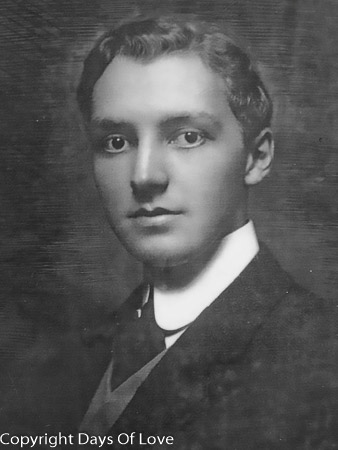 Henry
Davis Sleeper (1878-1934) was a nationally noted antiquarian, collector, and
interior decorator. Historical figures suspected of having same-sex desires
whose personal documents were destroyed include suffragist
Alice Paul, educator
M. Carey Thomas,
interior designer Henry Davis
Sleeper, and reformers Jane Addams,
Molly Dewson, and
Miriam Van Waters.
Henry
Davis Sleeper (1878-1934) was a nationally noted antiquarian, collector, and
interior decorator. Historical figures suspected of having same-sex desires
whose personal documents were destroyed include suffragist
Alice Paul, educator
M. Carey Thomas,
interior designer Henry Davis
Sleeper, and reformers Jane Addams,
Molly Dewson, and
Miriam Van Waters.
Henry Davis Sleeper was born March 27, 1878, in Boston to Major Jacob Henry Sleeper, a distinguished Civil War veteran and Maria (Westcott) Sleeper, their youngest son after Jacob and Stephen.[1] He was grandson of Jacob Sleeper, one of the founders of Boston University as well as a clothier and manager of a real estate trust.[1] Henry's education appears to have been by private tutors due to ill health as a child, and it is unclear as to whether he was ever formally educated.[1]
A. Piatt Andrew had been the leading light of a clearly homosexual circle since his graduate student days at Harvard in the 1890s, when he first caught the eye of Isabella Stewart Gardner, soon to become his close friend and adviser. Settling in Gloucester on Boston’s North Shore in 1900, he and a small but scintillating group of gay men and their lady friends—the latter including most notably Gardner and also portraitist Cecilia Beaux—created a discreet but intense bohemian enclave on Eastern Point. It was called Dabsville, a cryptogram of Sleeper’s for New York intellectual Joanna Stewart Davidge, Andrew, Beaux, the Philadelphia art patron Caroline Sinkler, and Sleeper, all of whom built adjoining houses on the point. At its heart were four men and another cryptogram. (“What acronymic antics they engaged in, those four,” wrote Joseph Garland of the male foursome: “Buswell, Andrew, Sleeper, Hammond—what BASHes!”) Author Andrew Gray described Dabsville this way: Sleeper, Beaux and Andrew ran the show … . Andrew [was] the king pin. The nucleus they formed … expanded to absorb people according to their wit, good looks, vivacity and capacity for self-dramatization … . They all drank very little—most worked rather hard, even when playing … .They were very hospitable to outsiders—Leslie Buswell and Jack Hammond among others—but surely rather snobbish toward people less verbally adept than they. They were very private people. The key … was the absence of children. No sailing, no nonsense, no preoccupation with childish things.
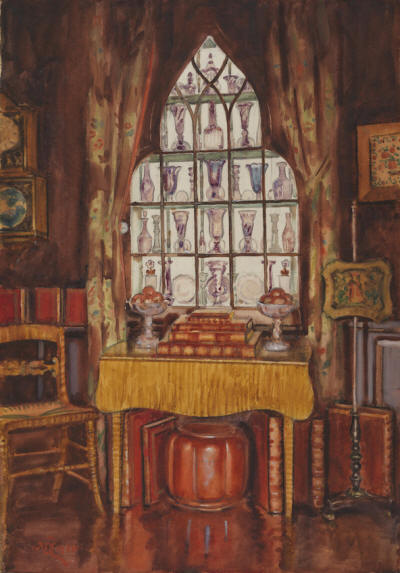
Amethyst Glass passage, Beauport, Sleeper–McCann House, 1928
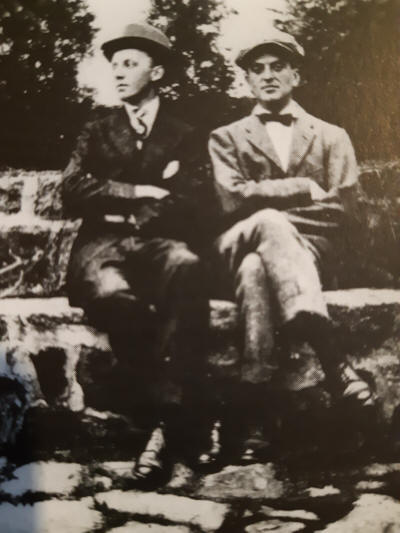
Sleeper and Andrew
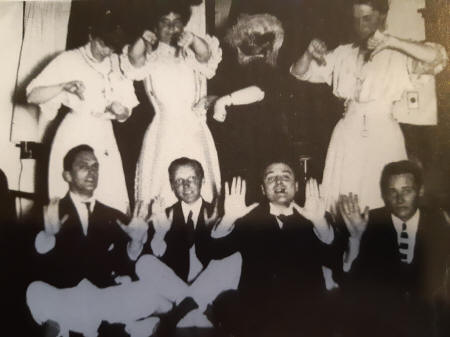
Cecilia Beaux (top right), A. Piatt Andrew (lower left) and Henry Davis
Sleeper (second from left)
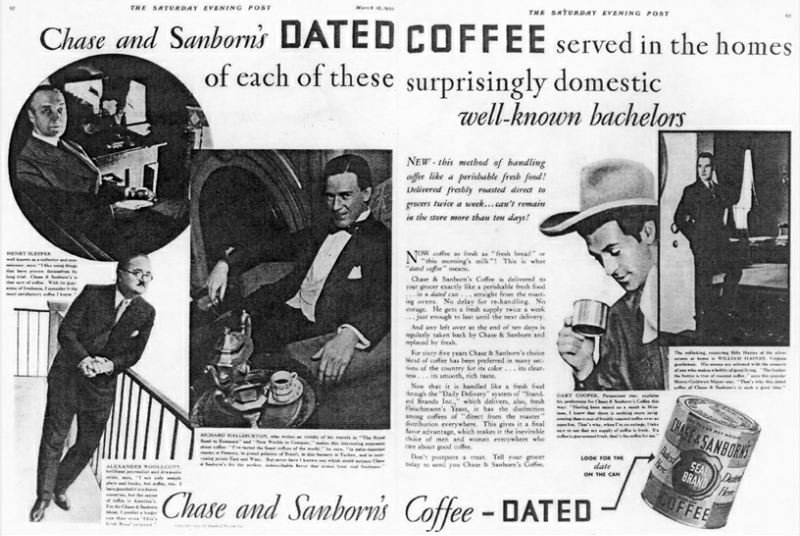
All the "bachelors" on this ad were actually gay men
Beauport, Gloucester, MA
Huntland or Joseph P. Thomas House, 35955 Huntland Farm Rd, Middleburg, VA 20117
Andrew met Henry Davis Sleeper in April 1906, perhaps at the home of George C. Lee, a noted horse breeder, yachtsman, and scion of one of Boston's grand Yankee families. Sleeper came from prominent Boston Methodist stock and his grandfather co-founded Boston University. There is no record of any formal education for Sleeper, though he was intelligent, well-read, slim, and good looking with one biographer calling him a "soft-faced interior decorator with a hatpin wit." Andrew became devoted to him. Sleeper was no social wall flower; within a few years he was one of Isabella Stewart Gardner's closest intimates and a designer for Joan Crawford and Frederic March.
Henry Sleeper was introduced to the Eastern Point in Gloucester, Massachusetts in the spring of 1906 by the Harvard economist A. Piatt Andrew who had built a handsome summer mansion, Red Roof, on a rock ledge above the harbor. Sleeper was much taken by the location and immediately decided to build a little further along the ledge from Red Roof. He purchased the land on Eastern Point in Gloucester on August 13, 1907.[1]
Although Henry Davis Sleeper, partial to Leslie Buswell, was himself always passionately loyal to A. Piatt Andrew, there are hints that Sleeper’s dogged devotion sometimes seemed suffocating to Andrew. Equally, according to Sleeper’s letters to Andrew, John Hays Hammond was “spellbound” by Buswell, while Buswell is described as “fond” of Hammond—though “fascinated by his genius.” Buswell, it seems, if he tried to hide his attraction to Andrew (at whose house he had met Hammond), did not entirely succeed. Hammond was “jealous of [Andrew’s] lure—& fears it,” Sleeper once wrote to Andrew, thereby doubtless hinting at fears of his own as well. At least he and Andrew never married anyone else. Both Hammond and Buswell did.
When Andrew and Sleeper met, Sleeper was living with his widowed mother at 336 Beacon St. in Boston. He was previously in a relationship with Guy Wetmore Carryl, a promising homorist and author who died from injuries sustained when his "bachelor cottage" in Swampscott caught fire. Sleeper kept at least three photographs of Carryl in his bedroom and Carryl's posthumous last novel had been dedicated to Sleeper. Carryl was first published in the New York Times when he was 20; his most famous line is "It takes two bodies to make one seduction."
Together, Sleeper and Andrew were the hit of Boston high society, on one date they attended the super-haute Myopia Hunt Club Ball at the Somerset Hotel. After more than a year together, their familial relationships became interesting. Sleeper share the Christmas gift Andrew gave him (a Napoleon medal) with his mother, who was most enamored with it. Yet Andrew spent Christmas in Indiana with his parents. On the other hand, while staying at Red Roof to oversee the construction of his estate, Beauport, Sleeper was a frequent visitor with Andrew's sister's family who lived nearby, and Andrew's niece begged to stay up late to spend time with him. Meanwhile, Andrew's mother sent Sleeper "the loveliest letter of the season" at Christmas in 1907.
Eastern Point was an enclave occupied by a somewhat louche group of "Bohemian" artists and intellectuals with frequent visits from some of the more colorful and unconventional members of Boston Society, in particular Isabella Stewart Gardner, the legendary art collector and builder of Fenway Court in the Back Bay Fens, now the Isabella Stewart Gardner Museum. Eventually Davidge, Andrew, Beaux, and Sleeper called their collection of summer houses on Eastern Point Dabsville, DABS containing the initials of the core members.[2]
Construction of Beauport, Sleeper's relatively modestly scaled Arts and Crafts-style house began in the fall of 1907 and was sufficiently finished to receive A. Piatt Andrew as a house guest in May 1908. As property flanking Sleeper's became available, Beauport was expanded several times until 1925, often in response to events or important experiences in his life. The house was now not only a home but a major showcase for Sleeper's interior design and decoration business. Clients could choose wallpapers, window treatments, or entire rooms to have reproduced in their own houses. Sleeper had a specialty in "Puritan Revival", the Jacobean-American architecture and decorative arts of the original American colonies, but his tastes and interests included French decor of several centuries and a great deal of orientalia.
Soon Andrew, Sleeper, and Gardner were tightly orbiting each other. In January 1908, for example, when Gardner was looking for Andrew, she would call Sleeper. Later, when Andrew was in Europe during WWI and he hadn't heard from Sleeper for several weeks, he sent word to Gardner to see if anything was wrong. The three sat with each other at the Majestic Theatre, the entertainment venue of choice for Boston's elite, and Gardner was a frequent visitor to Red Roof.
Henry Davis Sleeper and A. Piatt Andrew frequently socialized with Helen Storrow and her husband, while Henry James was a repeat guest at Red Roof. Sleeper and Andrew entertained most of Boston society, including Harry Frick and Archbishop (later Cardinal) O'Connell, who told Sleeper that he wished to visit Red Roof again. Sleepet was also a close friend of Ralph Adams Cram and was a pall-bearer at Arthur Little's funeral in 1925.
Sleeper served as the Director of the Museum of the Society for the Preservation of New England Antiquities from 1911 to 1913, and was a founding member and trustee of the Shirley-Eustis House Association.[1]
Two close friends of Henry Davis Sleeper and A. Piatt Andrew, John "Jack" Hammond and Leslie Buswell, met at Red Roof in the fall of 1914. They were immediately a couple. "Buswell is very fond of Jack, and fascinated by his genius, and J. is intensely spellbound by him," wrote Sleeper to Andrew. With Europe rushing to begin WWI, Sleeper was worried that the England born Buswell would have to be separated from Hammond if he was called to serve in his homeland's military. Buswell was an actor who eventually have up his career to manage Hammond's growing business. He lived with Hammond for several years before building his own estate next door and in 1928 he married and fathered a son. Hammond's father was an associate of Cecil Rhodes and very wealthy while Hammond, a noted inventor, went to Yale and then opened a workshop on his Gloucester estate. He married in 1925.
In March 1915, Andrew met with Captain Aime Doumenc, head of the French Army Automobile Service and pleaded his case for the American volunteers. They desired above all, he said, "To pick up the wounded from the front lines…, to look danger squarely in the face; in a word, to mingle with the soldiers of France and to share their fate!" [10] Doumenc agreed to a trial. The success of Andrew's Section Z was immediate and overwhelming. By April 15, 1915, the French created American Ambulance Field Service operating under French Army command. Andrew headed the organization, soon shortened to American Field Service, throughout the war, though his role changed significantly when its ambulance sections were taken over by the United States Army in late summer 1917. Andrew established a domestic organization based in Boston to recruit young American drivers and to raise funds from wealthy donors. The stateside office was headed by Henry Davis Sleeper and assisted by John "Jack" Hammond and former ambulance driver, Leslie Buswell. The French office was located at number 21 rue Raynouard, Paris.
In 1918, Sleeper became the U.S. Representative of and a major fundraiser for the American Field Service, an ambulance corps founded by A. Piatt Andrew early in World War I.[5] While Andrew served in the battle zones, Sleeper crisscrossed the Atlantic with supplies and funds, and worked closely with the French military. France awarded him the Croix de Guerre and the Legion of Honor.[2]
After the war, Sleeper's practice expanded and he won national recognition via prestigious periodicals and several high-visibility clients. Isabella Stewart Gardner commissioned work from him; Henry Francis du Pont engaged his assistance with the big new wing of the family's massive Delaware house, Winterthur, now a famed museum of American decorative arts; he designed for Hollywood stars Joan Crawford and Fredric March. In May 1934, he was granted an Honorary Membership in the American Institute of Architects.
Henry Davis Sleeper died in Massachusetts General Hospital of leukemia on September 22, 1934, and is buried in his family's plot in Mount Auburn Cemetery in Watertown and Cambridge, Massachusetts. Andrew wrote the memorial tribute published in the Gloucester Daily Times.
Sleeper had never married and left no direct descendants. Beauport was sold to Helena Woolworth McCann who was contacted by Henry Francis Du Pont urging that Sleeper's rooms remain exactly as they were as the value of the house and its collection of art objects depended primarily on their being left unchanged. Mrs McCann preserved the house as it was; at her death, the house was inherited by her daughters from whose hands it passed into the care of Historic New England in 1942.[1]
Beauport, Sleeper-McCann House was declared a National Historic Landmark in 2003.[2]
My published books: